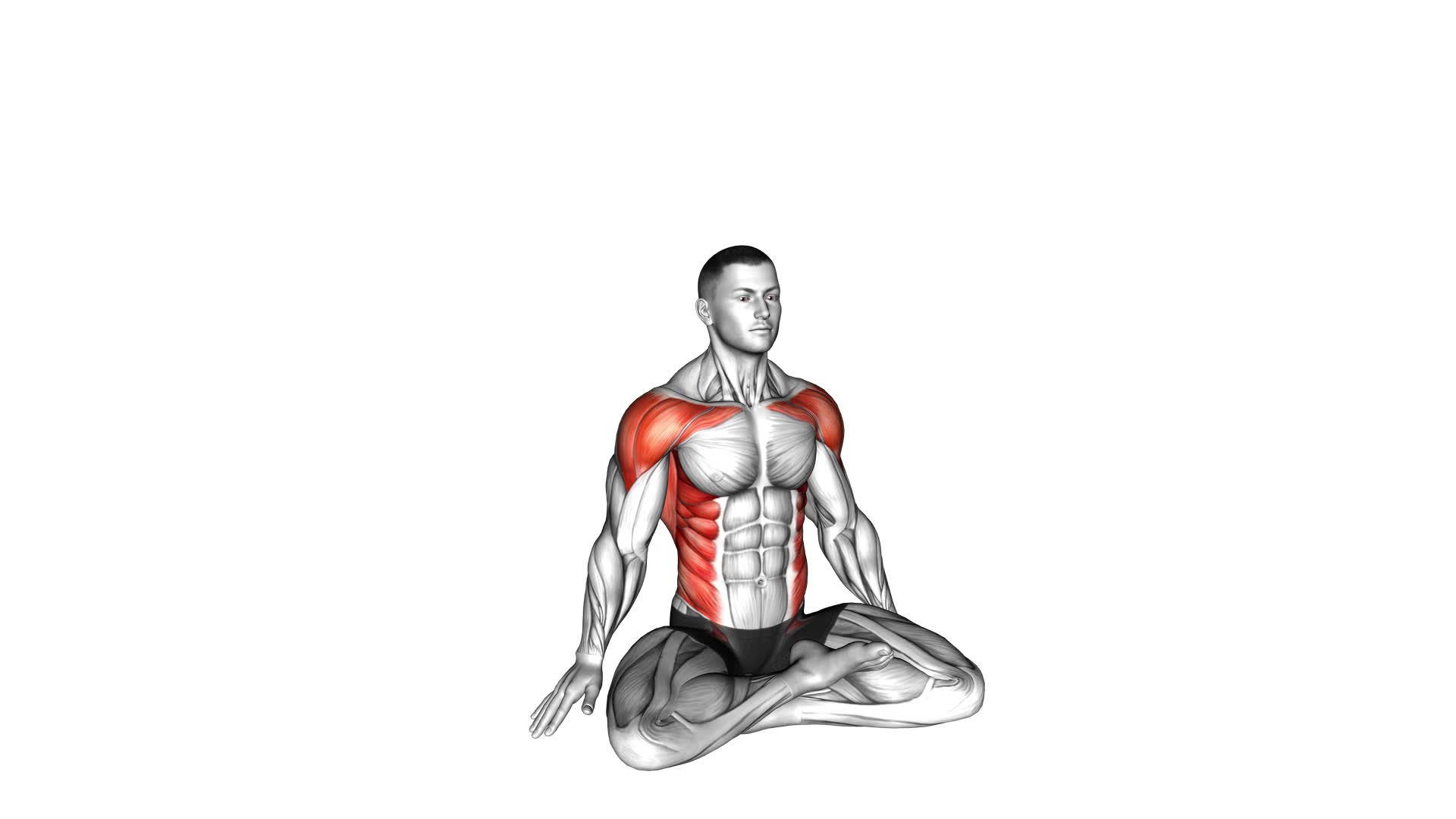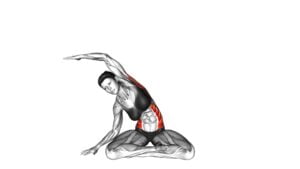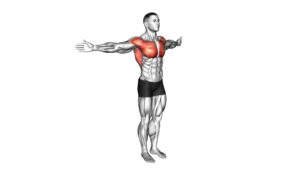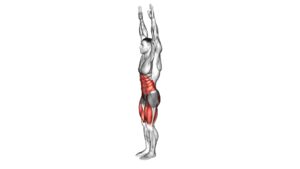Sitting Dynamic Side Stretch (male) – Video Exercise Guide & Tips

Are you looking for a dynamic stretch that targets your side muscles? Look no further than the Sitting Dynamic Side Stretch.
Watch This Exercise Video
In this video exercise guide, we'll show you how to properly perform this stretch to maximize its benefits.
With just a few easy steps, you'll be on your way to increased flexibility and improved overall fitness.
Don't miss out on this effective stretch – watch the video now and start incorporating it into your routine!
Key Takeaways
- The Sitting Dynamic Side Stretch increases flexibility and improves overall fitness.
- It targets the side muscles and enhances body posture.
- Connecting breath with movements enhances the effectiveness of the stretch and promotes a sense of calm and focus.
- Using a sturdy chair or bench and a yoga mat or towel for knee cushioning are the equipment and modifications needed for this exercise.
Benefits of the Sitting Dynamic Side Stretch
To experience the benefits of the Sitting Dynamic Side Stretch, incorporate this exercise into your routine. This stretch offers numerous advantages for your body and can be easily modified to suit your fitness level and needs.
Firstly, let's talk about equipment recommendations. For the Sitting Dynamic Side Stretch, you don't need any specialized equipment. All you need is a comfortable chair or bench to sit on. Make sure the chair is stable and provides adequate support for your back.
Now, let's discuss variations and modifications. If you're a beginner, you can start by performing the stretch without any added resistance. As you become more comfortable, you can gradually incorporate light dumbbells or resistance bands to increase the intensity of the stretch.
Another modification you can try is adjusting the height of the chair. Sitting on a higher chair will provide a deeper stretch, while sitting on a lower chair will make it easier to perform the exercise.
Equipment Needed for the Exercise
If you want to perform the Sitting Dynamic Side Stretch, you'll need a few pieces of equipment. The good news is that you don't need any fancy or expensive equipment for this exercise. All you need is a sturdy chair or bench and a yoga mat or towel to cushion your knees.
First and foremost, you need a chair or bench that's stable and can support your weight. Make sure it doesn't wobble or slide when you're performing the stretch. It's important to have a solid base to ensure your safety and stability during the exercise.
Additionally, using a yoga mat or towel to cushion your knees can be beneficial, especially if you have sensitive knees or are performing the exercise on a hard surface. The mat or towel will provide some extra padding and support, making the exercise more comfortable for you.
Modifications for beginners can be made by using a lower chair or bench and adjusting the range of motion. If you're just starting out, you can choose a chair or bench that's lower to the ground, which will make the stretch easier to perform. Additionally, you can start with a smaller range of motion and gradually increase it as you get more comfortable and flexible. Remember to listen to your body and only go as far as feels comfortable for you.
Step-by-Step Instructions for Proper Form
Now let's focus on the key points to keep in mind when performing the Sitting Dynamic Side Stretch.
As a beginner, it's important to pay attention to your form to maximize the benefits of this exercise. Avoid common mistakes such as rounding your back or using momentum to swing your body.
Form Tips for Beginners
Sit tall and engage your core while performing the Sitting Dynamic Side Stretch exercise. As a beginner, it's important to start with modifications that suit your level of flexibility. Here are some stretching techniques to help you get started:
- Take it slow: Don't push yourself too hard. Ease into the stretch and gradually increase the intensity as your body becomes more flexible.
- Use props: If reaching the floor is challenging, try using a block or bolster for support. This will help you maintain proper form and prevent strain.
- Listen to your body: Pay attention to any discomfort or pain. If something doesn't feel right, modify the stretch or stop altogether.
Common Mistakes to Avoid
To ensure proper form and avoid common mistakes, focus on maintaining a strong core and engaging the muscles while performing the Sitting Dynamic Side Stretch exercise.
One common mistake to avoid is rounding your back during the stretch. Keep your spine straight and tall throughout the movement to maintain proper alignment.
Another mistake to watch out for is allowing your shoulders to hunch forward. Keep your shoulders relaxed and down, away from your ears.
Additionally, avoid using momentum to swing your body from side to side. Instead, engage your core and use controlled movements to stretch your sides.
Benefits of Proper Form
To maximize the benefits of this exercise, ensure proper form by maintaining a strong core and engaging your muscles throughout the Sitting Dynamic Side Stretch.
Proper form not only enhances the effectiveness of the stretch but also helps prevent injuries. Here are the benefits of maintaining proper form:
- Improved flexibility: By engaging your muscles and maintaining proper alignment, you can safely stretch your side muscles, improving overall flexibility.
- Enhanced stability: A strong core and engaged muscles provide stability, allowing you to maintain balance and control during the stretch.
- Reduced risk of injury: By using proper form, you decrease the risk of straining or pulling muscles, ensuring a safe and effective workout.
Remember to focus on your breathing techniques and listen to your body. If you have any injuries or limitations, consult a professional who can provide modifications to suit your needs.
Common Mistakes to Avoid
One common mistake to avoid when performing the Sitting Dynamic Side Stretch exercise is leaning too far forward. It's important to maintain proper alignment throughout the exercise to prevent injury and maximize the effectiveness of the stretch. Leaning too far forward can strain the lower back and put unnecessary pressure on the spine.
Another common mistake isn't engaging the core muscles. The core plays a crucial role in stabilizing the body during the stretch. By activating the core muscles, you can maintain a strong and stable posture, allowing for a deeper and more effective stretch.
Additionally, rushing through the exercise is another mistake to avoid. It's important to perform the Sitting Dynamic Side Stretch with control and precision. Rushing through the movement can compromise form and lead to ineffective results. Take your time to breathe deeply and focus on the stretch, allowing your muscles to lengthen and relax.
Lastly, it's important to avoid bouncing or jerking movements during the stretch. This can put excessive strain on the muscles and joints, increasing the risk of injury. Instead, perform the exercise in a smooth and controlled manner, allowing for a gradual and progressive stretch.
Tips to Maximize the Effectiveness of the Stretch
To maximize the effectiveness of the sitting dynamic side stretch, there are several key points to keep in mind.
First, focus on your breathing techniques, taking deep breaths in and out as you perform the stretch.
Second, ensure that you maintain proper form and alignment throughout the exercise, keeping your back straight and shoulders relaxed.
Lastly, consider the duration and frequency of the stretch, aiming for consistency and gradually increasing the time spent in the stretch for optimal results.
Breathing Techniques for Stretch
To maximize the effectiveness of the stretch, focus on your breathing techniques. Proper breathing during a stretch not only enhances the physical benefits but also helps with mental focus and relaxation. Here are some tips to help you make the most out of your stretching routine:
- Deep Breathing: Take slow, deep breaths in and out during the stretch. This helps to oxygenate your muscles and promote relaxation.
- Exhale on the Stretch: As you move into the stretch, exhale slowly and fully. This helps to release tension and deepen the stretch.
- Mind-Body Connection: Pay attention to your breath and connect it with your movements. This helps to improve body awareness and enhance the effectiveness of the stretch.
Proper Form and Alignment
To maximize the effectiveness of the stretch, focus on maintaining proper form and alignment. Proper form and alignment are crucial when performing the sitting dynamic side stretch. Not only does it help prevent injuries, but it also ensures that you're targeting the correct muscles and receiving the full benefits of stretching.
When performing this stretch, make sure to sit up tall with your spine straight and shoulders relaxed. Keep your core engaged and your hips squared to the front. As you lean to the side, avoid collapsing or rounding your back. Instead, maintain a slight tilt towards the direction you're stretching.
By maintaining proper form and alignment, you can optimize the benefits of this stretch and prevent any unnecessary strain or discomfort.
Now let's move on to discussing the recommended duration and frequency for this exercise.
Duration and Frequency Recommendations
To maximize the effectiveness of the stretch, aim to perform the sitting dynamic side stretch for an appropriate duration and frequency. Consistency is key when it comes to stretching, so try to incorporate this exercise into your regular routine.
Here are some frequency recommendations and variations for advanced practitioners:
- Perform the sitting dynamic side stretch 3-4 times a week for beginners. This will help improve flexibility and range of motion gradually.
- For intermediate practitioners, increase the frequency to 5-6 times a week. This will allow for more significant improvements in flexibility and mobility.
- Advanced practitioners can perform the sitting dynamic side stretch daily or even multiple times a day, if desired. This level of frequency can help maintain and further enhance flexibility.
Remember to listen to your body and adjust the duration and frequency according to your individual needs and abilities. Always consult with a professional if you have any concerns or questions.
Modifications for Different Fitness Levels
How can you modify the sitting dynamic side stretch exercise for different fitness levels?
There are various ways to tailor this exercise to suit different fitness levels and individual needs.
For beginners or individuals with limited flexibility, you can start by performing the side stretch while sitting on a chair or using a stability ball for added support. This can help alleviate any strain on the lower back and make the exercise more accessible.
To increase the intensity of the stretch, you can gradually increase the range of motion by reaching further to the side. Additionally, incorporating a resistance band or light weights can add resistance and challenge the muscles even further.
For individuals with injuries or limitations, modifications can be made to protect and accommodate those specific areas. For example, if you have a shoulder injury, you can focus on performing the stretch on the opposite side or use a modified hand position that reduces pressure on the affected area.
For advanced progressions, you can incorporate dynamic movements such as reaching overhead or adding a twist to the side stretch. These variations can engage different muscle groups and provide a greater challenge to those who've already mastered the basic exercise.
Remember to always listen to your body and consult with a professional or fitness instructor if you have any concerns or specific needs.
Frequently Asked Questions
How Many Repetitions of the Sitting Dynamic Side Stretch Should I Perform?
To get the most out of the sitting dynamic side stretch, it's important to know how many repetitions to perform. The number of repetitions can vary depending on your fitness level and goals.
Generally, it's recommended to start with 8-10 repetitions on each side. This exercise is great for improving flexibility and targeting the muscles in your side.
Remember to maintain proper form by sitting tall and engaging your core.
Can the Sitting Dynamic Side Stretch Help Reduce Lower Back Pain?
The sitting dynamic side stretch can be beneficial for reducing lower back pain. By incorporating this stretch into your routine, you can improve overall flexibility and alleviate discomfort in the lower back area.
To properly execute the stretch, sit tall with your legs extended and gently lean to one side, feeling a stretch along the opposite side of your body. Repeat on both sides for optimal results.
Remember to listen to your body and never push past your comfort zone.
Is It Necessary to Warm up Before Performing the Sitting Dynamic Side Stretch?
Before performing the sitting dynamic side stretch, it's highly recommended to warm up your muscles. This helps prepare your body for the exercise and reduces the risk of injury.
When performing the stretch, focus on maintaining proper form. Sit up tall, engage your core, and reach your arm over your head while leaning to the side.
Incorporating this stretch into your routine can improve flexibility, reduce muscle tension, and alleviate lower back pain.
Can the Sitting Dynamic Side Stretch Be Done by Individuals With Limited Flexibility?
Yes, the sitting dynamic side stretch can be done by individuals with limited flexibility. There are stretch modifications that can be made to accommodate different levels of flexibility.
This exercise is beneficial for athletes as it helps improve range of motion, flexibility, and can prevent injuries.
Are There Any Precautions or Contraindications for Performing the Sitting Dynamic Side Stretch?
Before attempting the sitting dynamic side stretch, it's important to be aware of any precautions or contraindications. Certain individuals, such as those with back or hip injuries, may need to avoid this exercise.
It's also recommended to start with a lighter intensity and gradually increase as you become more comfortable. Remember to listen to your body and stop if you feel any pain or discomfort.
Consulting with a healthcare professional or fitness expert is always a good idea to ensure this stretch is safe for you.
Conclusion
In conclusion, the sitting dynamic side stretch is a beneficial exercise that helps improve flexibility and mobility in the torso and hips.
By following the step-by-step instructions and avoiding common mistakes, you can maximize the effectiveness of this stretch.
Additionally, modifications are available for individuals of different fitness levels.
Incorporate this exercise into your routine to enhance your overall flexibility and improve your posture.

Author
Years ago, the spark of my life’s passion ignited in my mind the moment I stepped into the local gym for the first time. The inaugural bead of perspiration, the initial endeavor, the very first surge of endorphins, and a sense of pride that washed over me post-workout marked the beginning of my deep-seated interest in strength sports, fitness, and sports nutrition. This very curiosity blossomed rapidly into a profound fascination, propelling me to earn a Master’s degree in Physical Education from the Academy of Physical Education in Krakow, followed by a Sports Manager diploma from the Jagiellonian University. My journey of growth led me to gain more specialized qualifications, such as being a certified personal trainer with a focus on sports dietetics, a lifeguard, and an instructor for wellness and corrective gymnastics. Theoretical knowledge paired seamlessly with practical experience, reinforcing my belief that the transformation of individuals under my guidance was also a reflection of my personal growth. This belief holds true even today. Each day, I strive to push the boundaries and explore new realms. These realms gently elevate me to greater heights. The unique combination of passion for my field and the continuous quest for growth fuels my drive to break new ground.







